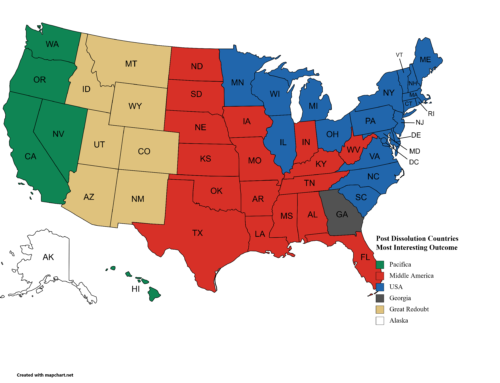How many of you are in a business whose investors or owners have set an aggressive growth goal for the company? Or perhaps you have been told you’re really great at something that you should scale up? Growth and scaling are natural and good goals for companies. It can be incremental, slowly building more capacity of what you do very well in a narrow lane, or it can be branching out to other related competencies. But growth and upscaling are often very difficult to manage. In this article, I’ll explain some of the issues that companies have as they scale their operations up a level or grow their operations to include related tasks outside traditional lanes. By the end, I hope to not dissuade you, but help you think through your strategy for growth through scaling. To do that, I’ll ask you to walk with me through a few scenarios as well as some science behind scaling to illustrate the issues at hand. In the end, I hope you’ll agree that exhaustively listing your assumptions and aggressively challenging and validating them will be the key to achieving your growth goals.
We need some examples to illustrate the issues at hand. Here are 3.
Several of my friends tell me I’m a great cook (hypothetically) and LOVE to come to my house to eat. Part of that is the way I prepare certain signature dishes, but part of that is the ambience created in my home. They like the package of good food in a welcoming and friendly setting. They have suggested I open a restaurant and scale my home experience. I realize that it would be difficult to be the only chef at restaurant scale and that I would have to hire staff to replicate aspects of that experience. To start with I’d have to, at risk, meaning with my own or borrowed money, rent restaurant space, pay to ensure water and gas and sewage lines all function properly, train a kitchen staff to recreate all 6 of my signature dishes as well as the staples a restaurant has to have to accommodate the desires of those whose dinner companions came for the signature dishes, but who themselves may be uninterested or unable to eat those foods. Furthermore,unlike my home where I can be very selective with my ingredients for the few times I cook these dishes for my friends, I would have to contract for sufficient supply of all the ingredients be on hand in sufficient quantity to prepare for a large number of servings each day I’m open. And if I want each dish to taste as good for every guest that comes in as I do for my friends, then I have to take the time to teach the line cooks to prepare those meals to my expectations and take the time to regularly taste the results to ensure they are to the standard I want my customers to experience. As you see, this process is truly possible, but it entails far more variables than just doing more of what I already do in my home kitchen.
How about if you’re the CEO of a small, but very reputable consultancy conducting training for several businesses. The small scale of your current work allows you to have your highly selected and developed team of subject-matter experts that work exclusively for you as the face of your program for your few client companies. You like it that way because you’re at your sweet spot of expertise, respect, and ability to pay your experts what they’re worth. Your clients are so satisfied with your work that they are willing to pay your price for the expertise you provide. This is your niche in the intellectual capitol realm. But when you decide to compete for and win that large-scale DoD contract, you will have to provide your training courses far more often to greater numbers of audience members. So your mode of two instructors interacting with a small seminar 6 times a year on a limited topic doesn’t necessarily translate here. You have to hire people to develop lessons according to strict requirements from your DoD client. You have to hire people who interact with the requirement managers and the contracting officers that follow far different procedures than your few long-time clients do. You need to hire a large number of instructors to teach these training courses 24 times a year around the globe. And the truth there is that the experts you might want are not available for the price point your DoD contract offers you. And you can’t push the few instructors you have to increase their work load over what they’re already doing. So you have to seek that right balance of experience for the price you’re willing (by the contract funding you’re given) to pay. It is very doable, but not as simple as just doing more of what you’re already doing so well on a small scale.
Finally, lets consider the example of the local contractor that builds foundations for tract homes and installs utility lines for the local municipality. You are proficient in building formwork, placing reinforcing steel and placing concrete for residential construction. You see there are two state contracts for bid, one to demolish and rebuild 10 bridges across the state and one to develop a large flood-control project in the mountains of your state. Being the contractor that wants to grow his business by scaling up to compete for the state contract, you have to ask yourself if winning the statewide contract will mean simply doing more of what you’re already doing, call that incremental growth, or whether this is a scaling opportunity in which you will integrate different competencies into the mix of what you’re doing today. Because you are looking to expand into land development, which requires a more diverse set of skills, you may need to acquire those skills by building out your team. But you will almost certainly need expertise in areas you aren’t considering, such as contract management, operations management, and safety. Being good at foundation construction may not translate as easily as you think to starting a bridge division. If your Bobcat throws a tread while making a water-diversion channel for your municipality, you probably have enough control over the project to absorb the time it takes to order a new one and replace it and still get the project done on time. But if you scale up and are selected for the state flood control project, your Bobcat won’t be enough. You will either have to purchase or lease the heavy equipment you need. With that comes the maintenance and scheduling responsibilities that come with the new equipment. In your scaled up work, changes to small variables magnify. If the price of steel suddenly rises due to increased tariffs prior to the point at which you purchased the steel, it is likely you will have to eat that cost. If 5 days of storms come through your area and you can’t pour concrete, that may be easier to absorb in a small project than a very large one. Of course, you are going to factor in delays into your proposal and the state will see that as reasonable to a certain degree. But what you have to be prepared for is how an unforeseen change in one variable can affect the entire project.
All of the above-mentioned scenarios appear to be natural extensions of a job you as an individual or your company is already doing well. But they all offer different typologies of business. Are the issues around scaling so generalizable that they can apply to all three of these differing examples? Yes. Let me explain why.
It seems a simple notion to scale up what you’re doing now to a larger audience or larger volume. After all, shouldn’t issues of scale be easily solved by just adding more of what you’re already doing? The simple answer seems like yes, but hidden in that yes is the nuance that as you get bigger and bigger, the more complicated the task, the more difficult scaling will be. The more excellence is expected, the more time and money it will cost. It might be easy to scale mass production of chicken bites or pizza or even simple HR training when good enough is a universally expected low bar. It is far more difficult to scale up when higher bars of excellence are expected or the costs of failure are as high as the profits from success. Why?
As you can see from the scenarios above, it is possible to control variables at small scale far more easily than you can at large scale. To discuss that further, allow me to bring in some real science that leaders considering growth should consider. Science actually explains why we underestimate how long something will take to do and why scaling up doesn’t always result in the same outcomes you get when you experiment. Lets look at some of that science.
In his Freakonomics podcast titled “Policymaking Is Not a Science”, Stephen Dubner discusses the science of using science, specifically to address scalability and why certain experiments that do so well in a controlled setting don’t translate when scaled up to the broader population. He discusses why, even though heart medication is so successful at treating individuals, so many don’t actually take their medicines. Or why so many people with cochlear implants don’t use them all the time. This got me thinking about businesses that want to scale up and move to the next level. Those two examples highlight simple and seemingly routine behaviors for someone to achieve specific desired outcomes: improve heart health and improve hearing. Yet, unexpectedly, science finds it difficult to explain why people won’t consistently do what ought to be routine. We must come to expect that if people don’t take their heart medicine, not everyone will follow all the procedures required to complete an objective in the time you think it ought to be done.
In that podcast episode on scaling Dubner spoke with the researchers (Omar Al-Ubaydli, John A. List, and Dana Suskind) of an important paper titled “THE SCIENCE OF USING SCIENCE: TOWARDS AN UNDERSTANDING OF THE THREATS TO SCALING EXPERIMENTS”. The authors pose some really important questions: “how should we use the experimental insights for policy purposes? We denote this as the “scale-up” problem, which revolves around several important questions: do the research results scale to larger markets and settings? When we scale the intervention to broader and larger populations, should we expect the same level of efficacy that we observed in the small-scale setting? If not, then what are the important threats to scalability? What can the researcher do from the beginning of their scholarly pursuit to ensure eventual scalability?”
Al-Ubaydli, List and Suskind find that “properties of the population” and “properties of the situation” have to be carefully considered for every scaling project. This boils down to assumptions we make when planning to scale up. It is important to take into account that if you want to achieve a specific outcome, you have to set the variables and their specific values to achieve the outcome you want (click here to see my previous post titled The Equation for more on this process). These considerations are what Nobel Prize-winning researcher Daniel Kahneman developed in what he terms “the planning fallacy.”
You can find some fascinating details on the planning fallacy in Kahneman’s book, Thinking, Fast and Slow, as well as numerous short articles about it on-line (here’s one). The gist of it is that “Overly optimistic forecasts of the outcomes of projects are found everywhere” (pg.250). This is because those forecasts are 1. unrealistically close to best case scenarios and 2. could be improved by simply looking at the empirical evidence of how other like projects do. Kahneman finds that leaders “make decisions based on delusional optimism rather than on weighing of gains, losses and probabilities. They overestimate benefits and underestimate costs.” This is why I included the information earlier on heart medication and turning on cochlear implants. If it is that hard to get individuals to do the things that are so obviously important to them on an individual level, how much more do we need to factor in that kind of “slop” when planning large upscale projects where more people, resources and processes come together?
Kahneman says that it starts with faulty premises that are not challenged. And that gets to why I say that the most important time you can spend is exhaustively list your assumptions and aggressively challenge and validate them. Alec Fisher, in The Logic of Real Arguments, says that the fundamental test of a logical argument is that the premises must be true and the conclusion must follow from the premises. If we don’t list and and validate our assumptions to ensure the premises are true, how can we possibly make accurate forecasts on how our upscaling project will turn out?
The point here is not to scare anyone away from scaling up their business to the next level. The great businesses of the world could never have been built without risk. Managing that risk and minimizing it wherever possible is what those who aspire to be great leaders ought to spend their time thinking about and planning for. Furthermore, this isn’t to say people are intellectually lazy. Far from it. But science shows over and over that people are more optimistic about their ability to control a situation than they ought to be. We also spend more time thinking about the possible gains rather than the probable hurdles. And we don’t seek out the data on how others fare who are doing what we are proposing to do.
This is why I argue that the time spent up front to exhaustively list out your assumptions, then aggressively challenge and validate those assumptions will be the most critical investment you can make in any scaling operation. More important than your initial capital. More important than your expert cooks, equipment operators and instructors. Grow that operation! Do so with confidence backed by analysis and not by confidence born of hope alone.
If you have questions or want to discuss this at greater length, drop me a note or give me a call.
Keep thinking…






Leave A Comment